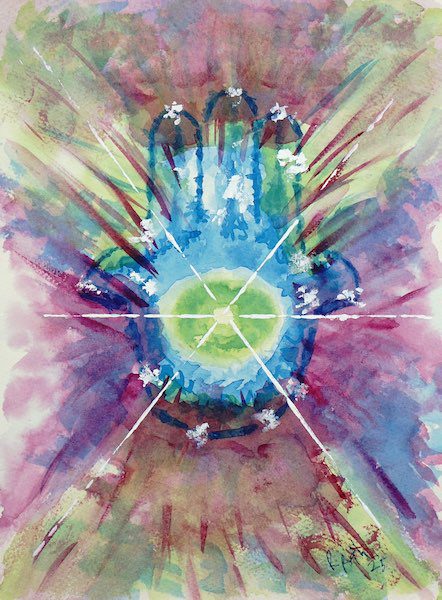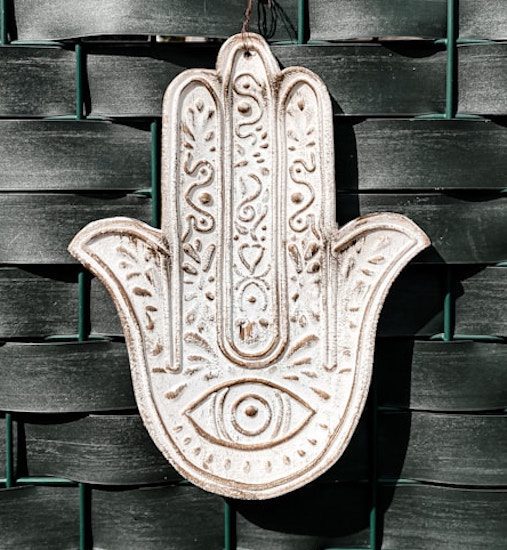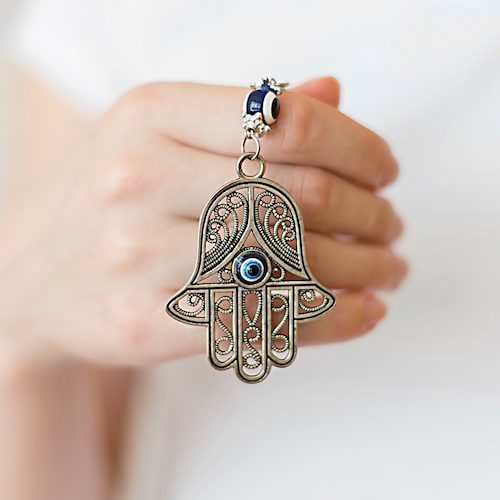
The Hamsa hand is a captivating symbol associated with protection and blessing. Its distinct shape and rich history makes it a beloved icon in Jewish culture. The Hamsa in Jewish art is everywhere. Depictions of this symbol grace paintings, jewelry, ornamentations on Judaica, and even architecture. In this blog post, we explore the origin and meaning of the Hamsa, and examples of this unique symbol in Jewish art.
The Origin of the Hamsa in Jewish Art

The origin of the Hamsa symbol goes back to ancient civilizations, including the Phoenicians and Egyptians. Early artistic representations depicted it as a simple hand outline, invoking protective powers. Its name derives from the Arabic word “khamsa,” meaning five, referring to the five fingers.
The Hamsa in Jewish art began appearing in manuscripts and decorative arts during the Middle Ages. Over time, Jewish artisans incorporated their interpretations of the Hamsa into art, layering it with cultural and spiritual significance. The Hamsa is not just a hand; it is a bridge connecting the past and present.
The Hamsa Symbol’s Deeper Meanings
Divine Protection
The Hamsa symbol signifies divine protection, guiding individuals through life’s challenges. In Hebrew, its called the Hamsa shel Miriam, honoring Miriam, the sister of Moses, who watched over him in the basket in the Nile. Hence the concept of protection.
Warding Off the Evil Eye
A profound belief surrounding the Hamsa is its ability to guard against the evil eye, a harmful malevolent gaze. In ancient times, people feared the evil eye as a harbinger of misfortune or injury. The Hamsa serves as a protective shield.
A Symbol of Blessing

Beyond protection, the Hamsa is a popular emblem of blessing and prosperity. Many believe displaying this symbol attracts positive energy and blessings into one’s life. Different designs, such as the incorporation of fish or eyes, further amplify these themes of abundance and happiness.
The Hamsa in Jewish Art and Modern Jewish Life
Today, the Hamsa remains a popular symbol in Jewish art and homes. Many homes display Hamsa charms or prints, believing they invite blessings while warding off negativity. The symbol’s appeal lies in its duality—providing both protection and a connection to Jewish identity. The Hamsa not only reflects cultural pride but also serves as a reminder of faith and spirituality. There is increasing demand for Hamsa amulets and artwork each year.
Conclusion: The Enduring Power of the Hamsa in Jewish Art and Culture
The Hamsa stands as a powerful symbol in Jewish culture, representing protection and blessing. As society evolves, this unique symbol retains important significance. It resonates with people seeking a connection to their roots, becoming a timeless symbol of hope and protection.
The design of the Hamsa varies widely, reflecting personal and regional artistry. It finds expression in jewelry, textiles, metalwork, and painting thus demonstrating its versatility and timeless legacy to Jewish artistic expression.
More in Judaica art and history – The Origin of the Star of David as a Jewish Symbol
Discover more from Rhonda Roth Art
Subscribe to get the latest posts sent to your email.

